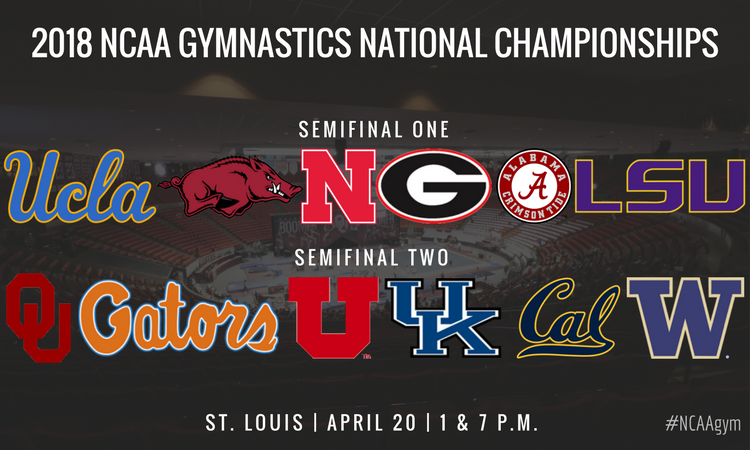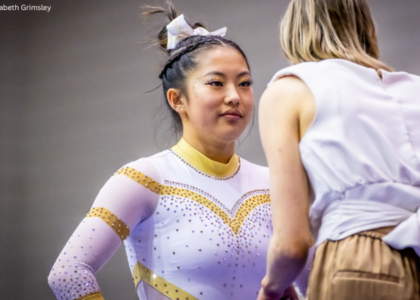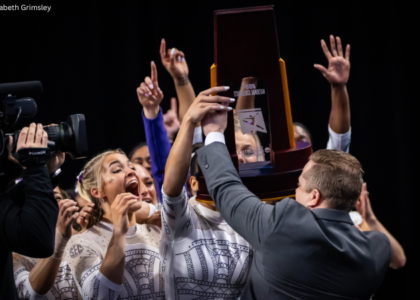The big show is finally here as the best collegiate gymnasts in the country travel to St. Louis to battle for national titles. But to get to the finals, they first have to make it through round one with only the top three teams in each session advancing to the Super Six. We take a look at each team’s chances and where potential upsets might occur.
Semifinal One with No. 2 LSU, No. 3 UCLA, No. 6 Alabama, No. 7 Nebraska, No. 10 Arkansas and No. 12 Georgia
| Rank | Team | NQS | Regional Score | High Score | Starting Event |
| 2 | LSU | 395.565 | 197.675 | 198.175 | Beam |
| 3 | UCLA | 395.490 | 197.650 | 198.275 | Vault |
| 6 | Alabama | 394.390 | 197.225 | 197.525 | Bars |
| 7 | Nebraska | 394.340 | 197.525 | 197.175 | Bye Before Bars |
| 10 | Arkansas | 393.595 | 196.775 | 197.300 | Bye Before Floor |
| 12 | Georgia | 393.015 | 196.500 | 197.525 | Floor |
The afternoon will kick off with a nail biter of a semifinal. Each of the six teams here have made it to the Super Six at some point in their team history, but only three have won the coveted championship trophy. LSU and UCLA have been neck and neck all season and have been fighting each other for second place. Alabama and Georgia have seen tough losses but remain in solid upset positions, especially for Georgia as seen by its regionals performance. Arkansas is having a groundbreaking season and Nebraska can never be counted out—especially after its stellar regionals performance—but what do we expect from it come crunch time?
LSU seems like the easy choice to advance to the Super Six in this bunch. The Tigers have been consistent and have benefited from junior Sarah Finnegan’s breakout year, but they had an average performance at regionals. Despite winning in Raleigh, beginning on floor brought out the nerves, and while minor mistakes are OK in a regionals setting, they could be the difference between third and fourth in the semifinal. LSU begins on beam, which can be a worrisome event for even the best beam workers, especially in the high energy atmosphere of a semifinal. Erin Macadaeg, Myia Hambrick and Finnegan are incredibly consistent on the event, so it’ll be dependent on how well the freshmen duo of Reagan Campbell and Christina Desiderio hold up. Another average meet like in Raleigh could end its Super Six dreams quick, but if it performs to the highest ability, it’ll ward off UCLA and can even put up a fight against Oklahoma on Saturday.
Speaking of UCLA, the Bruins are having a fantastic year, showing shades of the 2010 national championship squad. UCLA gets the luxury of Olympic order and will look to take advantage of ending on beam and floor. Vault and bars are weak spots for the Bruins; however, having Madison Kocian back on bars after offseason surgery provided a nice bump at regionals. Beam is a solid event for the Bruins, but all eyes will be on UCLA’s floor performance. Katelyn Ohashi went viral earlier in the year for her Michael Jackson routine and has received three perfect 10s.
Let’s assume UCLA and LSU are locks for the Super Six, which given performances this season is highly likely. Which team will round out the first set of qualifiers? It very well could be Alabama. Alabama started off the season with lackluster meets. It lost Mackenzie Brannan to an Achilles injury and Wynter Childers had her own aches and pains for much of the season. But it also found a high-scoring all arounder in freshman Lexi Graber. Graber has been a highlight for the Tide, scoring above a 39.000 in all six of her all around appearances and regularly hits 9.900 on bars. Alabama proved during regionals it has the fire it was missing early in the season. If it has meets like the first half of 2018, it’s vulnerable to the teams seeded below it.
Nebraska, Arkansas and Georgia cannot be counted out of this conversation. All are capable of making it to the Super Six. While it’s unlikely these three teams could beat UCLA or LSU, it’s not impossible, and all have the ability to overtake Alabama with a weak meet. Nebraska is no stranger to high pressure situations. It came close to beating Oklahoma earlier this season and was a very close second at regionals to LSU—no means a bad meet for the Tigers. If pressure works best for Nebraska, this situation is perfect.
Arkansas is another likely contender and could be this session’s sleeper qualifier. The Razorbacks raised the stakes this year after a season filled with injuries and disappointment in 2017. Sarah Shaffer was named Freshman of the Year in the SEC and Sophia Carter has her own weekly honors to hold on to. Each has been a big boost to the Razorback squad thus far and could be the main ingredients in an upset if others falter.
The final contender comes as somewhat of a surprise. Georgia’s struggles have been well-documented this season as it has been plagued with injuries, oftentimes only putting up five gymnasts on multiple events. But the team’s slogan from the 1999 championship-winning team—a wounded dog is a dangerous dog—still reigns true as the team fought back to qualify to nationals in its final routine in Tuscaloosa. If Georgia is to upset, it’ll be thanks to the likes of all around due Sydney Snead and Rachel Dickson, beam and floor star Sabrina Vega and the ability to put six on each event again and give the gymnasts the leeway of dropping any potential mistakes.
Semifinal Two with No. 1 Oklahoma, No. 4 Florida, No. 5 Utah, No. 8 Kentucky, No. 9 California and No. 11 Washington
| Rank | Team | NQS | Regional Score | High Score | Starting Event |
| 1 | Oklahoma | 396.120 | 198.000 | 198.375 | Beam |
| 4 | Florida | 395.115 | 197.725 | 198.150 | Bars |
| 5 | Utah | 395.015 | 197.475 | 198.150 | Vault |
| 8 | Kentucky | 393.850 | 197.050 | 197.100 | Bye Before Bars |
| 9 | California | 393.615 | 196.725 | 197.500 | Bye Before Floor |
| 11 | Washington | 393.235 | 196.275 | 197.400 | Floor |
It is easy to glance at this semifinal and assume Oklahoma, Florida and Utah will advance without giving much thought to the other three teams. All three had significantly higher regionals scores—though comparing those across regionals is a fraught business—and they have all notched at least one 198 this year. The bottom three have not hit that mark nor even really come close. It will take work, and likely mistakes from the top teams, for Kentucky, California or Washington to advance. But Florida and Utah have opened the door for opponents throughout the season. An upset is not out of the realm of possibility.
The closest sure thing in gymnastics right now is OU advancing to Super Six. The Sooners scored a 198 or better eight times this season (Florida and Utah each only did it once), and their “bad” meet at the Perfect 10 Challenge was still a 196.425. If the Sooners repeat that performance, they will be vulnerable, but the likelihood of KJ Kindler’s beam squad scoring a low 48 twice in one season is scant. Early in the year, floor looked like a big question mark for a team that was without Natalie Brown and was suffering from uncharacteristic mistakes from stalwarts like AJ Jackson and Maggie Nichols. That rotation score has settled into the 49.500-range in the last month of competition, and beam has become the low scoring event for the team, granted still sitting at about a 49.300. The Sooners will start with that lowest scoring event, where they are still ranked a measly No. 1. The treat of the competition will be watching Oklahoma finish on bars where it can put up massive totals. The Sooners’ high bar score this season is a 49.725—just 0.275 in deductions across all five counting scores, and an average counting score of 9.945. Oklahoma’s work, especially at nationals, is characterized by attention to the tiniest details. Look for gorgeous lines, toe point, eye contact, attention to head position in choreography and precise landings. Barring an utter meltdown, we will see Oklahoma on Saturday.
For Utah and Florida, the key in this semifinal will be to compete a clean and solid meet. If the Utes and Gators have strong showings, they will be hard to beat, but both are somewhat vulnerable to a lights out performance from the bottom three. Utah’s place is more secure than Florida’s. The Utes’ have been consistently in the mid-197s for most of the year. Its low score, a 196.800 at Michigan, is a number that would still likely top Kentucky and California on either teams’ normal day. Utah is fairly consistent across all four, and has been given the coveted Olympic order draw. The leg events are both strengths, led by big performances from MyKayla Skinner and MaKenna Merrell-Giles. Bars and beam, though rarely true disasters, are not as strong. Beam in particular can be a problem event, and is the only piece where the Utes have scored below a 49 all season. The Utes share the highest floor score of the season with UCLA: a huge 49.775 (that’s 0.225 in deductions and an average of 9.955 in the five counting scores). They haven’t scored below a 49.250 all year and were below 49.400 only four times. Big difficulty and strong performance quality set Utah apart, and closing the meet on floor should allow everyone in the lineup to go all out.
The Gators are in a more tenuous position. Their lone 198 came before they lost Kennedy Baker for the season (we’re still crying). A solid, normal meet for Florida falls right around a 197.700, a score none of the bottom three teams have hit this year. That said, the Gators have put up a few too many mid to high 196s in the second half of the year to feel too comfortable. All three of the 196s the Gators have recorded since February have been away and have included a counting fall. At Georgia, two falls on beam suppressed the score, and at Missouri and SECs, two falls on floor kept the total down. The Gators just have too many routines that can fall into the 9.700s in lineups to count a low score and still put up a big total. Starting on bars should get Florida off on the right foot; the Gators regularly put up a 49.400-49.500 on the event. It is the second and fourth rotations—beam and floor—where Florida’s fate will likely be decided. Beam, though consistently strong in the last handful of meets, had rocky moments early in the season. Floor has been up and down in the last stretch and could be the place where the Gators open the door. The Gators close their meet on vault, a relatively secure event, where they haven’t scored below a 49.425 since early February. They will then sit on a bye, waiting with fans to see if an upset will happen.
Kentucky, California and Washington are all capable of advancing to the Super Six if one of the top teams has a misstep, and Cal’s high ceiling makes the Bears a dangerous team. That big 197.500 came when the Bears upset the Utes and featured a very strong bar rotation. Bars was Cal’s weakest event early in the season, and figuring out that lineup has been a big part of its late season success. Still, the Bears sits at a high 196 regularly, so it will take a huge performance or a mistake from a top team if we’re going to see Cal in its first Super Six. The Bears start on a bye before moving to floor, an event where they can put up a big score, though haven’t done so consistently this season. If an upset is in the works, Cal needs to be in the mid-49s after the second rotation. The Bears have a lower vault ceiling, so a successful rotation will look more like a 49.250. If Cal is sitting above a 98.600 halfway, keep an eye out for mistakes from the other teams because it will be on pace for an upset-worthy score. Bars and beam will be difference makers. To put pressure on the top teams and place themselves as upset contenders, the Bears need strong numbers on each piece. Cal hasn’t had a big miss on beam since the first meet in February, so the goal will be a normal closing rotation.
Washington is also capable of the upset. The goal this season for the Huskies was to prove that last year’s trip to nationals was no fluke. Though UW’s ceiling is lower than Cal’s, the Huskies have been above 197 more often (four times to Cal’s two) and boast a significantly higher average. Washington starts on floor, an event that can be its best, with highs topping out at 49.475. With a normal floor rotation, the Huskies will position themselves well moving into their worst event in the second rotation. Vault is a big question this year; Washington’s clean Yurchenko halves have not been scoring well, and with only one 10.000 start value, much of the lineup tends to fall in the 9.7s. A Super Six team can’t afford counting scores in the 9.700 in regular circumstances. UW closes on beam, the event on which it clinched its nationals berth last year. It has been a less-solid event in 2018, but the Huskies are still capable of gorgeous work and big scores. Washington will do all it can, then spend the last rotation on a bye.
Kentucky’s big win was qualifying to nationals for the first time in program history. The Wildcats should already be thrilled but shouldn’t view the semifinals as just a victory lap. If Cal and UW don’t have extraordinary meets, and if one of the top three opens the door, they could sneak in. The Wildcats start on a bye and then move to bars, an event that has been fairly consistent in the low-49s. For an upset-worthy team total, they need to score at least a 49.250 here. Beam in the third rotation is the biggest question for this team. The Wildcats have had two big misses on the event, and their highest total in the past month is only 49.025. Kentucky needs to break 49 to feel comfortable but needs more to content. Floor is regularly Kentucky’s best, so look for a big number in the fifth rotation. Vault is another must-hit-49 event for this team. The Wildcats consistently hover around that mark, though when they break 197, the vault total has been closer to 49.200.
Want to receive the latest collegiate gymnastics news in your inbox? Sign up for the NCAA Gym NewsLetter here.
Article by Emily Minehart and Alicia Bettano





Haley Roy for UW has a 10.0 vault